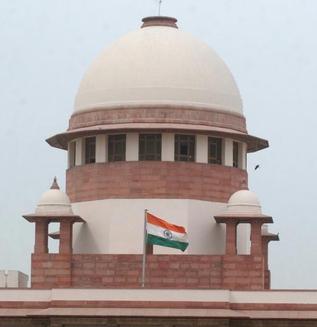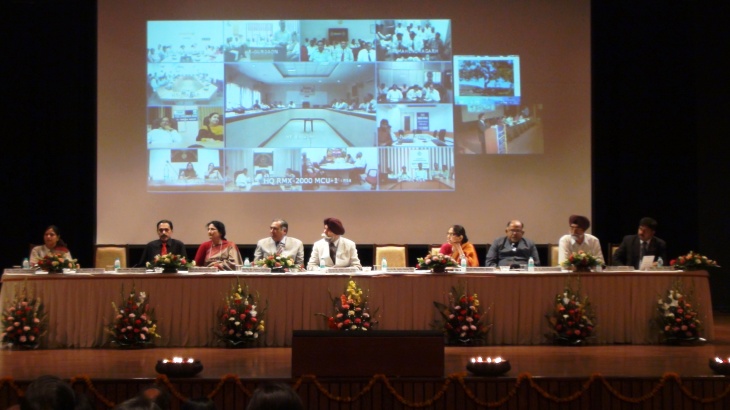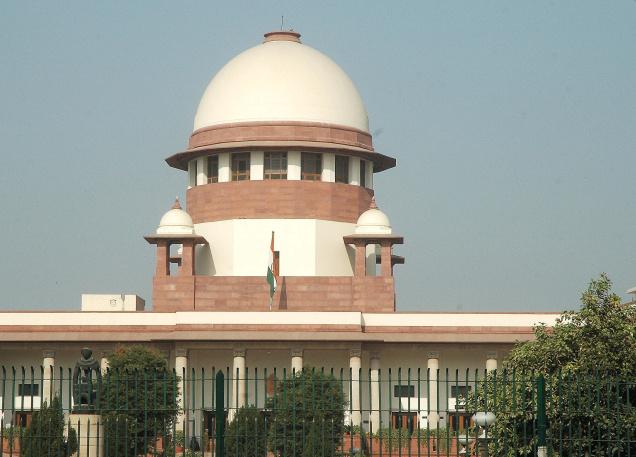
Supreme Court of India
Two British men were sentenced to six years in jail in India on Friday for sodomising young boys living at a children’s shelter.Supreme Court justices P. Sathasivam and B. S. Chauhan said the men were “evil influences” on the children who had sought safety at the Anchorage Shelter Home in Mumbai in a ruling upholding a 2006 lower court verdict. Duncan Grant and John Allan Waters were accused of sodomy and sexual assault by a 15-year-old boy who lived at the Anchorage Shelter Home in Mumbai. Other boys had made similar complaints.The shelter had been set up by Grant, a London charity worker, with money raised in Britain. Retired Royal Navy Lieutenant Commander Grant and Waters “had sex with children on multiple occasions”, the judges said.
The two men were not in India when the charges were filed in 2001.Grant, who also ran children’s charities in Tanzania, was extradited from the African nation in 2004. Waters was extradited from the United States in the same year after Interpol alerts were issued against the men. According to a 2007 national study in India, half of the 15,000 children and young adults surveyed said they had suffered some form of sexual abuse. A fifth of the child respondents said they had experienced severe sexual abuse, according to the study, conducted by Ministry of Women and Child, Government of India and backed by the United Nations.
In the year 1986, a petition was brought before the High Court of Bombay complaining about the plight of children at various children homes in Maharashtra. In the same petition, the High Court appointed a Committee, namely, the Maharashtra State Monitoring Committee on Juvenile Justice (in short “the Committee”) headed by Justice Hosbet Suresh, a retired Judge of the High Court of Bombay. This Committee received some complaints from the Child Rights Organizations like Saathi Online, Childline and CRY about the mismanagement of Anchorage Shelters, and on that basis, the Committee sought permission of the High Court to visit various Anchorage Shelters.
After visiting various Anchorage Shelters including the one at Colaba and Cuffe Parade, a report was submitted before the High Court.2(b) On the basis of the said report, specifically expressing unconfirmed report of sexual exploitation of children, on 17.10.2001, one Ms. Meher Pestonji telephoned Advocate Ms.Maharukh Adenwala and informed her that some children residing in Shelter Homes were sexually exploited by those who were running these Homes.
On receiving this information, Ms. Maharukh Adenwala met those boys, who were allegedly sexually assaulted, at the residence of Ms.Meher Pestonji to ascertain the truth. After confirming the said fact, Ms. Maharukh Adenwala thought it proper to inform it to the Members of the Committee. After consulting the Committee, Ms. Maharukh Adenwala moved a suo motu Criminal Writ Petition No 585 of 1985 before the High Court.On 19.10.2001, the High Court passed an order for the protection of the children at Anchorage Shelter Homes. On 21.10.2001, one Shridhar Naik telephonically contacted Ms Maharukh Adenwala and informed her that the order of the
High Court giving protection to the children was being misinterpreted by the police and, therefore, certain3 clarifications were sought from the High Court and by order dated 22.10.2001, the High Court clarified the same.
With regard to the sexual and physical abuse at the Anchorage Shelters, on 24.10.2001, Childline India Foundation filed a complaint with the Cuffe Parade Police Station and while lodging the said complaint, Ms. Maharukh Adenwala was also present there. In spite of the fact that a complaint had been lodged, the police did not take cognizance of the offence under the pretext that the matter was sub judice and was pending before the High Court. Since the matter was not being looked into by the police, Ms. Maharukh Adenwala recorded statements of some of the victims and informed the said fact to the Members of the Committee. On 28.10.2001,Dr. (Mrs.) Kalindi Muzumdar and Dr. (Mrs.) Asha Bajpai met those victims at the office of India Centre for Human Rights and Law and endorsed that the statements previously recorded by Ms. Maharukh Adenwala were correctly recorded. After ascertaining the correctness of the statements by the Members of the Committee, the said facts were placed before the High Court and it was also submitted that the police4 authorities at Cuffe Parade Police Station were not seriously pursuing the complaint. The High Court, by order dated 07.11.2001, directed the police authorities of the State of Maharashtra to take action on the basis of the complaint lodged by the Childline India Foundation.
Based on this specific direction, Sr. Inspector of Police,Colaba Police Station was directed to investigate in detail the complaint lodged by Childline and to take such action as is required to be taken in law. On 12.11.2001, Colaba Police Station recorded the statement of one Sonu Raju Thakur and the statement of one Sunil Kadam (PW-1) was recorded by Murud police station on 13.11.2001. On 15.11.2001, police ultimately registered an offence at Colaba police station by treating the statement of Sonu Raju Thakur as formal First Information Report (in short ‘the FIR’) being C.R. No. 312/2001 and started investigation.
Though the offence was mainly registered against three accused barring William D’Souza, the remaining two accused, namely, Allan John Waters and Duncan Alexander Grant had already left the country and 5 therefore, on 05.04.2002, an Interpol Red Corner Notice was issued against Allan and Duncan. In pursuance of Red Corner Notice,Allan was arrested in USA and sometimes thereafter Duncan also surrendered before the Court in India. The Metropolitan Magistrate committed the case to the Court of Session and after committal, it was initially assigned to the First Track Court at Sewree. All the three accused pleaded not guilty and,therefore, claimed to be tried.
The Sessions Judge, by judgment dated 18.03.2006, convicted William D’Souza for the offence punishable under Section 377 read with Section 109 IPC, Sections 120B and 323 IPC and under Section 23 of the JJ Act. Allan John Waters was convicted under Section 377 IPC, Section 120B read with Section 377 IPC and Section 373 IPC. Duncan Aleander Grant was convicted under Section 377 IPC,Section 373 read with 109 IPC, Section 372 IPC and Section 23 of JJ Act.
Aggrieved by the said order, William filed Criminal Appeal No.681 of 2006, Duncan and Grant filed Criminal Appeal No. 476 of 2006 before the High Court of Bombay. State Government also preferred Criminal Appeal No. 603 of 2006 before the High Court for enhancement of the sentence of the accused persons. The High Court, vide its common judgment dated 23.07.2008, set aside the order of conviction passed by the Sessions Judge and allowed the criminal appeals filed by the accused and acquitted all of them from the charges levelled against them and dismissed the appeal filed by the State Government.
Aggrieved by the order of the High Court, Childline India Foundation and Ms. Maharukh Adenwala filed Criminal Appeal Nos. 1208-1210 of 2008 and State of Maharashtra has filed Criminal Appeal No. 1205-1207 of 2008 before this Court by way of special leave petitions.
Constitutional provisions relating to children
Children are the greatest gift to humanity. The sexual abuse of children is one of the most heinous crimes. It is an appalling violation of their trust, an ugly breach of our commitment to protect the innocent. There are special safeguards in the Constitution that apply specifically to children. The Constitution has envisaged a happy and healthy 34childhood for children which is free from abuse and exploitation. Article 15(3) of the Constitution has provided the State with the power to make special provisions for women and children. Article 21A of the Constitution mandates that every child in India shall be entitled to free and compulsory education upto the age of 14 years. The word “life” in the context of article 21 of the Constitution has been found to include “education” and accordingly this Court has implied that “right to education” is in fact a fundamental right.
Article 23 of the Constitution prohibits traffic in human beings, beggars and other similar forms of forced labour and exploitation. Although this article does not specifically speak of children, yet it is applied to them and is more relevant in their context because children are the most vulnerable section of the society. It is a known fact that many children are exploited because of their poverty. They are deprived of education, made to do all sorts of work injurious to their health and personality.
Article 24 expressly provides that no child below the age of 14 years shall be employed to work in any factory or mine or engaged in any hazardous employment.This Court has issued elaborate guidelines on this issue. The Directive Principles of State Policy embodied in them Constitution of India provides policy of protection of children with a self- imposing direction towards securing the health and strength of workers, particularly, to see that the children of tender age is not abused, nor they are forced by economic necessity to enter into avocations unsuited to their strength.
Article 45 has provided that the State shall endeavor to provide early childhood care and education for all the children until they complete the age of fourteen years. This Directive Principle signifies that it is not only confined to primary education, but extends to free education whatever it may be upto the age of 14 years. Article 45 is supplementary to Article 24 on the ground that when the child is not to be employed before the age of 14 years, he is to be kept occupied in some educational institutions. It is suggested that Article 24 in turn supplements the clause (e) and (f) of Article 39, thus ensuring distributive justice to children in the matter of education. Virtually, Article 45 recognizes the importance of dignity and ersonality of the child and directs the State to provide free and compulsory education for the children upto the age of 14 years.
The Juvenile Justice Act was enacted to provide for the care, protection, treatment, development and rehabilitation of neglected or delinquent juveniles and for the adjudication of such matters relating to disposition of delinquent juveniles.This is being ensured by establishing observation homes,juvenile houses, juvenile homes or neglected juveniles and special homes for delinquent or neglected juveniles.
Even in the case of Vishal Jeet vs. Union of India,(1990) 3 SCC 318 this Court issued several directions to the State and Central Government for eradicating the child prostitution and for providing adequate and rehabilitative homes well manned by well qualified trained senior workers, psychiatrists and doctors.
The above analysis shows our Constitution provides several measures to protect our children. It obligates both Central, State & Union territories to protect them from the evils, provide free and good education and make them good citizens of this country. Several legislations and directions of this Court are there to safeguard their intent. But these are to be properly implemented and monitored. We hope and trust that all the authorities concerned through various responsible NGOs implement the same for better future of these children.
Under these circumstances, the impugned judgment of the High Court acquitting all the accused in respect of charges leveled against them is set aside and we restore the conviction and sentence passed by the trial Judge.
 The Bill, which contains progressive aspects such as streamlining adoption procedures and extending the law’s protection to orphans and abandoned children, still suffers from the problems highlighted by the parliamentary panel. The government, unfortunately, did not accept the view that children in a particular age group being subjected to the adult criminal justice system will violate their right to equality under Article 14 and the objective of protecting children in Article 15(3) of the Constitution. It, however, dropped a clause that provided for treating those who had committed crimes before reaching the age of 18 but were apprehended after they turned 21, agreeing that it was unconstitutional. It extended the period of preliminary assessment (the original draft called it ‘inquiry’) by the Juvenile Justice Board to determine whether a juvenile offender should be sent for rehabilitation or tried as an adult, from one month to three months. The board’s assessment will still be subject to judicial review and may set off litigation over whether one 16-year-old was let off lightly or another was wrongly sent to an adult court. Such decisions may also be influenced by the prevailing public mood. It would have been wiser to have let the law stand in conformity with the UN Convention on the Rights of the Child, which advocates equal treatment of all children under the age of 18. The difference between sober assessment and mercurial action cannot be more starkly emphasised.
The Bill, which contains progressive aspects such as streamlining adoption procedures and extending the law’s protection to orphans and abandoned children, still suffers from the problems highlighted by the parliamentary panel. The government, unfortunately, did not accept the view that children in a particular age group being subjected to the adult criminal justice system will violate their right to equality under Article 14 and the objective of protecting children in Article 15(3) of the Constitution. It, however, dropped a clause that provided for treating those who had committed crimes before reaching the age of 18 but were apprehended after they turned 21, agreeing that it was unconstitutional. It extended the period of preliminary assessment (the original draft called it ‘inquiry’) by the Juvenile Justice Board to determine whether a juvenile offender should be sent for rehabilitation or tried as an adult, from one month to three months. The board’s assessment will still be subject to judicial review and may set off litigation over whether one 16-year-old was let off lightly or another was wrongly sent to an adult court. Such decisions may also be influenced by the prevailing public mood. It would have been wiser to have let the law stand in conformity with the UN Convention on the Rights of the Child, which advocates equal treatment of all children under the age of 18. The difference between sober assessment and mercurial action cannot be more starkly emphasised.


